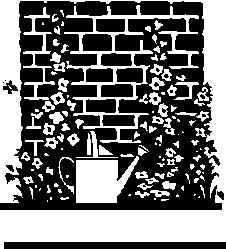Green Building
Your Home Landscape
A green building is one where the indoor and outdoor environmental qualities have been considered and protected during its design, construction, maintenance and use. A house that incorporates green building principles is said to be "built green". Your home landscape can be built green too. A well-designed yard needs less water and maintenance which saves money. For instance, conventional grass lawns have a high impact because of water use, pesticide use, and air pollution generated from lawn mowers. Instead, consider landscaping with drought-resistant native plants and perennial groundcovers. Proper planning and design can also enhance the "health" of your landscape while shielding your home from weather extremes.
Use Native Plants
A built green landscape uses native vegetation that competes well with weeds and other pests. These plants are native to your region and climate. Emphasize plant diversity with a palette of plants that naturally grow together, are reseeding, and spread without much maintenance. This strengthens the ecology of your yard requiring less fertilizer and pest control. Native plants also attract more birds, butterflies, and other wildlife. When purchasing native material, be sure the plants have not been collected from the wild. Gathering plants from the wild can destroy small remaining patches of wild native plants. Plant containers should be labeled "nursery-propagated". Plant material should be used which has come no further than a 50-mile radius from your garden. This ensures that the plants are hardy in your area. Obtain plants from local sources to also minimize transporting them long distances.
 Avoid planting trees and shrubs that are considered invasive by threatening the local native ecosystem. While not an all-inclusive listing, the major plants of concern include: Norway maple, sycamore maple, Japanese barberry, Japanese honeysuckle, burningbush, Russian olive, rugosa rose, multiflora rose, Asiatic bittersweet, porcelainberry, and purple loosestrife.
Avoid planting trees and shrubs that are considered invasive by threatening the local native ecosystem. While not an all-inclusive listing, the major plants of concern include: Norway maple, sycamore maple, Japanese barberry, Japanese honeysuckle, burningbush, Russian olive, rugosa rose, multiflora rose, Asiatic bittersweet, porcelainberry, and purple loosestrife.
Save water
Using native plants helps reduce water requirements. Locally grown native plants may already be accustomed to the climate making them drought resistant and able to withstand greater climate variations than non-native plants.
Covering the ground around your plants with two or three inches of mulch helps to reduce water evaporation and stormwater runoff. Weed growth is curtailed and weed pulling is easier. Apply water during the cooler times of the day, usually mornings and evenings. Use a low-pressure sprinkler that makes a circular pattern. Oscillating sprinklers can lose up to 50% of water to evaporation on hot days.
Improve air quality
Where planting adjacent to building openings such as air intakes, entries, or operable windows, avoid allergy-causing plantings and those requiring chemical treatment.
allergy-causing plantings and those requiring chemical treatment.
Better soil quality
Have your soil tested and implement on-site soil remediation measures such as introducing earthworms if they are sparse, adding organic matter and microorganisms to break down pollutants. In addition to conserving soil moisture, mulch also restores soil fertility, which reduces the need for fertilizers. Leave grass clippings, small plant debris, and fallen leaves to decompose on the ground or start a backyard compost pile. Use less or no pesticides and herbicides; plant disease-resistant species. And use organic methods to control pests and for fertilizer. Use your compost in lieu of peat moss which is a non-renewable resource.

Plant for energy savings
A well-designed landscape can help reduce energy bills. Placing a windscreen of evergreens, such as white pine or white spruce on the northwest side of your house will block winter winds. If your air conditioner cannot be located on the north side of the house, then shade it with a tree or tall shrubbery. This will help to keep it cool in the summer and reduce energy use. Planting large deciduous shade trees, like maple and oak, on the east, west, and/or south sides of your house will shade the summer sun and keep your house cooler. Without foliage during the winter, the tree will allow the house to bask in the sun helping to reduce energy costs.
Landscape construction materials
When constructing retaining walls and other landscape structures, avoid using CCA-treated wood. This is wood treated with copper arsenate, an inorganic waterborne preservative which increases the life of the wood that is used where degradation from moisture. Rainwater can leach CCA from the treated wood contamination soil and water. Instead, construct walls, patios, decks, arbors, and fences from stone, brick or concrete and from products made from recycled materials such as plastic lumber. Inert materials such as concrete and stone and alternative wood products help to reduce solid waste problems, cut energy consumption in manufacturing, and save on natural resource use. Some alternative wood products are made of a mixture of recycled polyethylene and wood. It does not require weatherproofing, does not warp or splinter, and resists rot and termites. Outdoor furniture made from recycled wood and plastics is also available. Gravel-size pieces of recycled glass, called "cullet" can also be used for gravel paths and patios.
Additional Sources of Information
The Environmental Building News
Oikos/Green Construction Source
U.S. Green Building Council
Building Online
Water Wiser
U.S. Department of Energy
The Green Building Source Book
High Performance Building Guidelines NYC Department of Design & Construction
Landscape Construction Materials from Recycled Content
This information is provided as a service to those professionals in the construction industry. This information does not include all available references and does not constitute an endorsement by DEEP. Use of this information does not in any way lessen your responsibilities for compliance with applicable federal, state, and local laws.
Green Building
Content Last Updated February 2020

